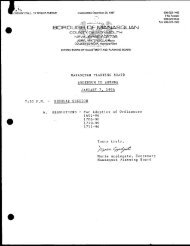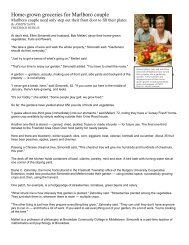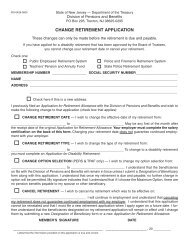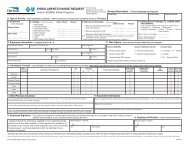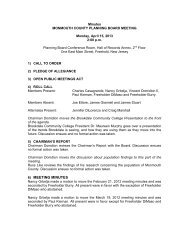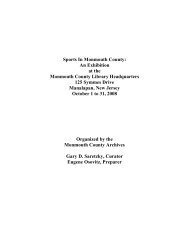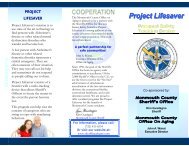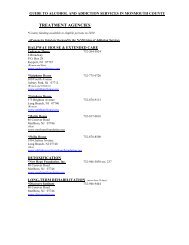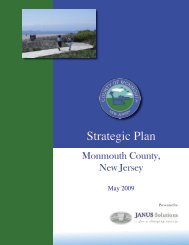NATURAL and CULTURAL FEATURES of MONMOUTH COUNTY
NATURAL and CULTURAL FEATURES of MONMOUTH COUNTY
NATURAL and CULTURAL FEATURES of MONMOUTH COUNTY
You also want an ePaper? Increase the reach of your titles
YUMPU automatically turns print PDFs into web optimized ePapers that Google loves.
foot wide navigation channel; the Kill Van Kull connects Newark Bay with Upper New York<br />
Harbor, <strong>and</strong> is about 5 miles long <strong>and</strong> 800 feet wide, ranging in depth from 11 to 50 feet<br />
(USACE, 2004). Tidal movement in the Kill Van Kull mixes water between Newark Bay <strong>and</strong> the<br />
Upper Bay, particularly during spring tides; while tidal excursions in the Arthur Kill are<br />
significantly shorter <strong>and</strong> usually don’t generate a complete transfer <strong>of</strong> water between Newark<br />
<strong>and</strong> Raritan Bays (NY/NJCOST, 2004). In fact, the residence time for water in the Arthur Kill is<br />
about 2 weeks, but because its tides at the Raritan Bay <strong>and</strong> the Kill Van Kull are so balanced, the<br />
direction <strong>of</strong> its net flow remains definitively undefined (Waldman, 1999).<br />
Sea level drops more rapidly in the shallower Raritan Bay than in the deeper Upper New York<br />
Bay, <strong>and</strong> wind can enhance or negate the effect <strong>of</strong> tides in the Kills <strong>and</strong> Raritan Bay (Chant et al.,<br />
2006). Strong westerly winds over the NY Bight region pushes water towards the east into the<br />
ocean, <strong>and</strong> lowers the water level in Raritan Bay; if this occurs for several days, it can result in<br />
higher net flows out <strong>of</strong> Newark Bay through the Kill van Kull <strong>and</strong> into the ocean (Chant et al.,<br />
2006; NY/NJCOST, 2004; Pence et. al., 2005). Several days <strong>of</strong> easterly winds raises the water<br />
level in Raritan Bay, <strong>and</strong> causes water to flow from the Kill van Kull into Newark Bay, which<br />
then empties into the Arthur Kill (Chant et al., 2006; NY/NJCOST, 2004; Pence et. al., 2005).<br />
Although the Arthur Kill is likely not the channel for filling <strong>and</strong> emptying Newark Bay,<br />
northerly winds can create a “set-down” <strong>of</strong> the Arthur Kill at Perth Amboy <strong>and</strong> drive water out<br />
<strong>of</strong> Newark Bay (Chant et al., 2006). Northwesterly winds can drop sea level <strong>and</strong> drive a strong<br />
southerly flow out <strong>of</strong> the Arthur Kill into Raritan Bay against the tide (as flow is entering the<br />
eastern Kill van Kull (Chant et al., 2006). During east-west winds, the currents turn first at the<br />
Kill van Kull, then an hour later at Newark Bay, then 2 hours after that at the Arthur Kill (Chant<br />
et al., 2006).<br />
Seventeen hundred tankers carry 18 billion gallons <strong>of</strong> petroleum into NY Harbor every year<br />
(Waldman, 1999). Some <strong>of</strong> the world’s largest petroleum importing, refining, <strong>and</strong> storage<br />
facilities are located on the Arthur Kill: the ConocoPhillips’ Bayway Refinery in Linden, the<br />
Hess facility in Woodbridge, <strong>and</strong> the Chevron refinery in Perth Amboy (NY/NJCOST, 2004;<br />
USGS, 2007). The Bayway Refinery, located in the Tremley Point area <strong>of</strong> Linden, was<br />
originally the St<strong>and</strong>ard Oil Refinery, built on a former racetrack by John D. Rockefeller in 1909;<br />
it was later owned by Exxon <strong>and</strong> Tosco, <strong>and</strong> presently has the capacity <strong>of</strong> processing about<br />
250,000 barrels <strong>of</strong> crude oil a day (Colorantshistory.org, 2007). In 1990, over a million gallons<br />
<strong>of</strong> oil spilled into the Kills during the first 6 months <strong>of</strong> the year (USACE, 2004; Waldman,<br />
1999). This included 567,000 gallons <strong>of</strong> No.2 fuel oil from a ruptured pipeline at the Bayway<br />
Exxon on January 2, 1990 ; about one quarter <strong>of</strong> this spill was recovered by 680 people, 60,000<br />
feet <strong>of</strong> boom, 40 vacuum trucks, 10 skimmers, <strong>and</strong> 70 vessels (Waldman, 1999). Two months<br />
later an explosion on Cibro Savannah barge owned by Citgo Petroleum Corporation released<br />
127,000 gallons <strong>of</strong> No.2 heating oil (Waldman, 1999). Then the tanker BT Nautilus ran aground<br />
near the Bayonne Bridge on the Kill Van Kull on June 7, <strong>and</strong> spilled 260,000 gallons <strong>of</strong> heavy<br />
No.6 fuel oil (Waldman, 1999). In 1991, 11 out <strong>of</strong> 15 million dollars in Exxon’s penalties paid<br />
for financed restoration, l<strong>and</strong> acquisition, <strong>and</strong> environmental studies <strong>of</strong> the Arthur Kill<br />
(Waldman, 1999).<br />
Combined Sewer Overflows <strong>and</strong> sewage treatment plants discharge into the Arthur Kill<br />
(example: the Joint Meeting <strong>of</strong> Essex <strong>and</strong> Union Counties, the Linden-Roselle Sewerage<br />
Authority, <strong>and</strong> the Rahway Valley Sewerage Authority); <strong>and</strong> at least 16 tributaries discharge into<br />
the Arthur Kill (USACE, 2004). The Kills have a number <strong>of</strong> derelict vessels; the Arthur Kill<br />
alone has 275 wrecks within five “vessel graveyards” along the Staten Isl<strong>and</strong> shoreline (USACE,




